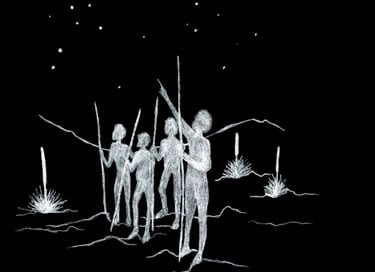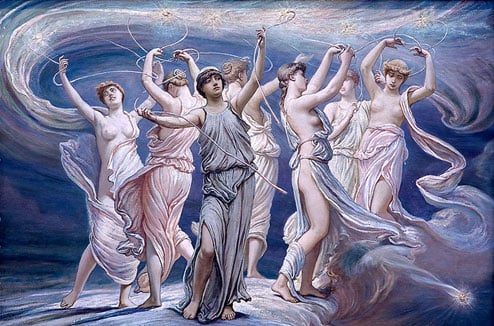Australian Aboriginals knew of variable star Betelgeuse before European astronomers
Recent research published in the Journal of Astronomical History and Heritage suggests that an ancient Aboriginal love story written in the sky reveals their knowledge of variability in the star Betelgeuse, the ninth brightest star in the night sky and second brightest in the constellation of Orion.
Betelgeuse, also known as Alpha Orionis, is a variable star whose magnitude varies between 0.2 and 1.2. This means that the star brightens and fades over a period of about 400 days. The variation in Betelgeuse's brightness was believed to have been observed with a telescope in 1836 by Sir John Herschel, when he published his observations in Outlines of Astronomy. However, the recent study suggests the Australian Aboriginals knew of its variability long before this time, according to a report in ABC Science.
Early last century, famous anthropologist Daisy Bates spent 16 years living among the Aboriginal people of South Australia’s Great Victoria Desert, recording their daily lives, lore, and oral traditions. Among her archived notes are stories regarding the Aboriginal astronomical traditions of this region.
One story, now referred to as “The Orion Story” involves the stars making up the constellations of Orion and Taurus. According to the legend, the story tells how the constellation Orion (called ‘Nyeeruna’), which is often portrayed as a male hunter, chases after the Pleiades star cluster, usually portrayed as a group of seven sisters (‘Yugarila’). Standing between Nyeeruna (Orion) and Yugarilya (Pleiades cluster), is their eldest sister Kambugudha, represented by the Hyades star cluster. Kambugudha taunts Nyeeruna by standing before him. The club in Nyeeruna's right hand, which is the star Betelgeuse, fills with 'fire magic' ready to throw at Kambugudha. However, she defensively lifts her foot, which is the star Aldebaran and also full of fire magic, causing Nyeeruna great humiliation and putting out his fire.

The Australian Aboriginals have been recording astronomical phenomena in their oral histories for thousands of years. Photo credit: Paul Curnow and Gail Glasper
A detailed analysis of the complete story led researchers from the University of New South Wales to suggest that the reference to the ‘fire magic’ of Betelgeuse is an observation of the star in its bright phase, while reference to ‘putting out his fire’ is an observation of the fading of Betelgeuse.
"This is very interesting because this ancient story accurately describes the variability of Betelgeuse, which brightens and fades over a period of about 400 days," said one of the study authors, Dr Duane Hamacher.
Hamacher explains that other parts of the Orion Story refer to sparks coming from Nyeeruna's body, when he's filled with lust for the seven sisters. "The sparks coming from Nyeeruna, match the radiant of the annual Orionids meteor shower produced by Earth's passage through the debris trail of the comet Halley, which typically peaks over the last two weeks of October," said Hamacher.
Hamacher, and co-author Trevor Leaman, suggest that the Orion story is similar to myths and legends found in many other cultures around the world, including Greek mythology and legends from cultures across Asia, South America, and Africa.

In the Greek myth of the Pleiades, a group of seven sisters were transformed into a cluster of stars, and were chased by a man seen in the Orion stars. Photo source: Wikipedia.
"There's always a debate about why these stories are so similar from different places around the world," says Hamacher. "It could be contamination from one culture to another, but I think it's simply that as humans we perceive natural phenomena in certain similar ways”.
Featured image: The star Betelgeuse in the constellation of Orion. Photo source.


















Comments
Hi Luccas,
I understand your frustration, we don't particularly like the ads either, but it is what enables us to run. In a nutshell, no ads means no ancient-origins.
Regarding the captcha, you can avoid it by registering for free from the link on the top menu. Only guests have to use the captcha, without it we are bombarded by spam. The feedback we have had so far is that people much prefer the image puzzle captcha that we have compared to the random numbers.
April Holloway
"From Around the Web (Sponsored)"
Putting this between content and the Comments really makes me want to skip scrolling to the Comments section, I know you need to monetize somehow but is it really worth pissing off viewers so much? Considering you have no control over the content of this (Sponsored) section, I hate seeing the same lame content on every site I visit. Combined with the ultra hard Captcha, the comments section will be left un-read by me if this continues.
I love stories that tell me something that's so obvious but that needed saying, i.e. that aboroginal people know a lot more than we give them credit for (or maybe we quietly give them credit but need to come as saying that they are a lot LOT more intelligent and 'human' than the stereotypical bushman living under the sun talking an old language. I love the myth in this too. Thanks for posting.
looks like some wardrobe malfunctions there...
p.s. I've got some great ancient star stories to tell...but this is a good one !